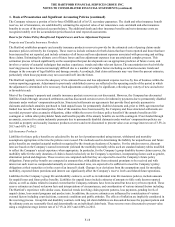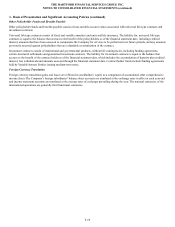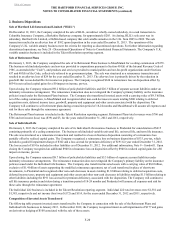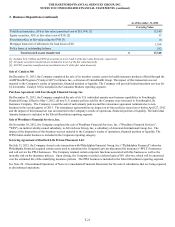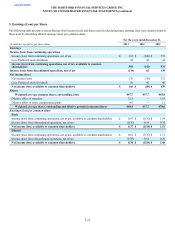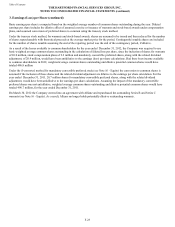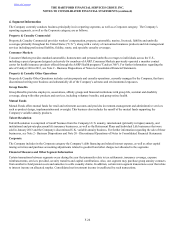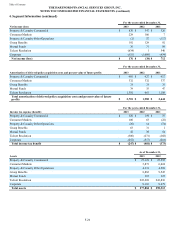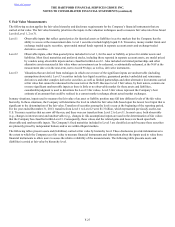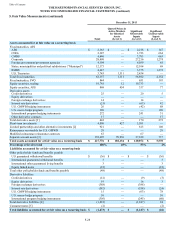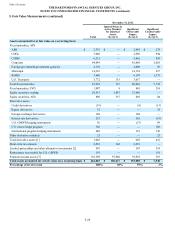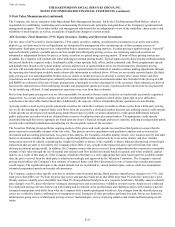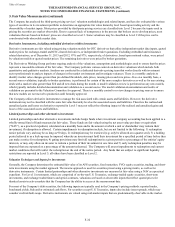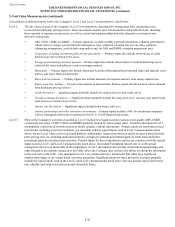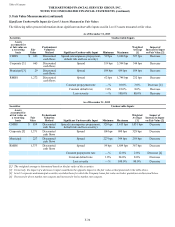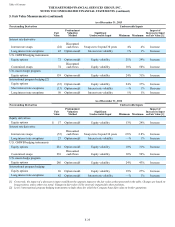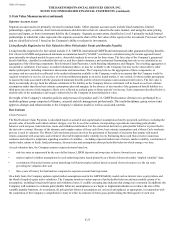The Hartford 2013 Annual Report Download - page 163
Download and view the complete annual report
Please find page 163 of the 2013 The Hartford annual report below. You can navigate through the pages in the report by either clicking on the pages listed below, or by using the keyword search tool below to find specific information within the annual report.
F-27
5. Fair Value Measurements
The following section applies the fair value hierarchy and disclosure requirements for the Company’s financial instruments that are
carried at fair value. The fair value hierarchy prioritizes the inputs in the valuation techniques used to measure fair value into three broad
Levels (Level 1, 2 or 3).
Level 1 Observable inputs that reflect quoted prices for identical assets or liabilities in active markets that the Company has the
ability to access at the measurement date. Level 1 securities include highly liquid U.S. Treasuries, money market funds and
exchange traded equity securities, open-ended mutual funds reported in separate account assets and exchange-traded
derivative securities.
Level 2 Observable inputs, other than quoted prices included in Level 1, for the asset or liability or prices for similar assets and
liabilities. Most fixed maturities and preferred stocks, including those reported in separate account assets, are model priced
by vendors using observable inputs and are classified within Level 2. Also included are limited partnerships and other
alternative assets measured at fair value where an investment can be redeemed, or substantially redeemed, at the NAV at the
measurement date or in the near-term, not to exceed 90 days; as well as, derivative instruments.
Level 3 Valuations that are derived from techniques in which one or more of the significant inputs are unobservable (including
assumptions about risk). Level 3 securities include less liquid securities, guaranteed product embedded and reinsurance
derivatives and other complex derivative securities, as well as limited partnerships and other alternative investments carried
at fair value that cannot be redeemed in the near-term at the NAV. Because Level 3 fair values, by their nature, contain one
or more significant unobservable inputs as there is little or no observable market for these assets and liabilities,
considerable judgment is used to determine the Level 3 fair values. Level 3 fair values represent the Company’s best
estimate of an amount that could be realized in a current market exchange absent actual market exchanges.
In many situations, inputs used to measure the fair value of an asset or liability position may fall into different levels of the fair value
hierarchy. In these situations, the Company will determine the level in which the fair value falls based upon the lowest level input that is
significant to the determination of the fair value. Transfers of securities among the levels occur at the beginning of the reporting period.
For the year ended December 31, 2013, transfers from Level 1 to Level 2 were $1.3 billion, which represented previously on-the-run
U.S. Treasury securities that are now off-the-run, and there were no transfers from Level 2 to Level 1. In most cases, both observable
(e.g., changes in interest rates) and unobservable (e.g., changes in risk assumptions) inputs are used in the determination of fair values
that the Company has classified within Level 3. Consequently, these values and the related gains and losses are based upon both
observable and unobservable inputs. The Company’s fixed maturities included in Level 3 are classified as such because these securities
are primarily priced by independent brokers and/or are within illiquid markets.
The following tables present assets and (liabilities) carried at fair value by hierarchy level. These disclosures provide information as to
the extent to which the Company uses fair value to measure financial instruments and information about the inputs used to value those
financial instruments to allow users to assess the relative reliability of the measurements. The following table presents assets and
(liabilities) carried at fair value by hierarchy level.
Table of Contents THE HARTFORD FINANCIAL SERVICES GROUP, INC.
NOTES TO CONSOLIDATED FINANCIAL STATEMENTS (continued)



